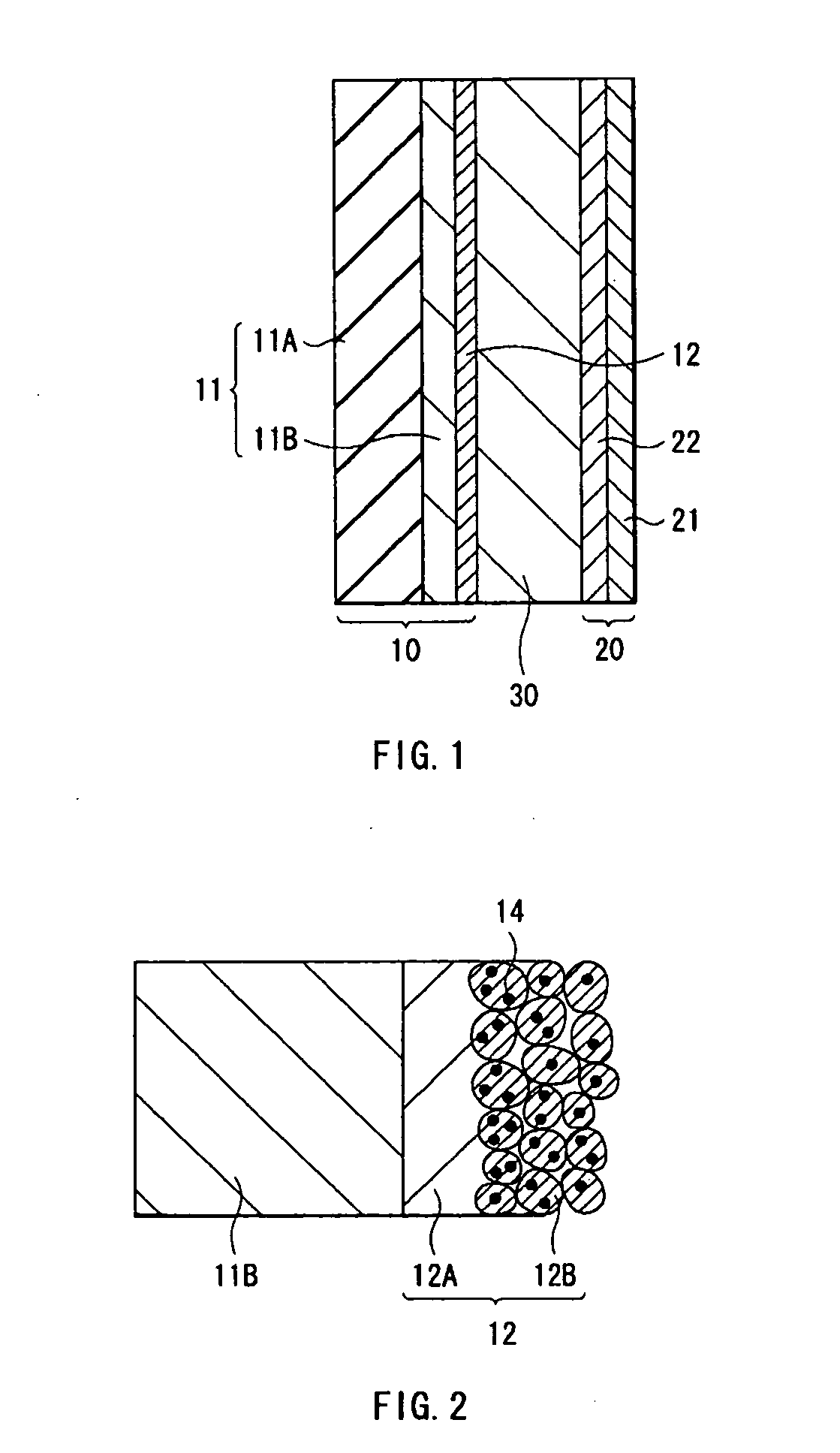Photoelectric conversion device
a conversion device and photoelectric technology, applied in the direction of electrolytic capacitors, metal/polymethine dyes, electrolytic capacitors, etc., can solve the problem of insufficient conversion efficiency of the photoelectric conversion device, achieve higher conversion efficiency, improve conversion efficiency, and improve conversion efficiency
- Summary
- Abstract
- Description
- Claims
- Application Information
AI Technical Summary
Benefits of technology
Problems solved by technology
Method used
Image
Examples
first embodiment
[0041]FIG. 1 schematically shows the cross-sectional configuration of a photoelectric conversion device according to an embodiment of the present invention. FIG. 2 selectively shows main parts of the photoelectric conversion device of FIG. 1 in enlarged scale. The photoelectric conversion device illustrated in FIGS. 1 and 2 corresponds to the main parts of a so-called dye-sensitized solar cell. The photoelectric conversion device includes a working electrode 10 and a facing electrode 20 facing each other with an electrolyte inclusion 30 in between. At least one of the working electrode 10 and the facing electrode 20 is an electrode having optical transparency.
[0042]The working electrode 10 has, for example, a configuration where a metal-oxide semiconductor layer 12 is provided on a conductive substrate 11, and a dye 14 is carried on the metal-oxide semiconductor layer 12 acting as a carrier. The working electrode 10 functions as a negative electrode to an external circuit. The condu...
second embodiment
[0074]Next, a second embodiment of the present invention will be described. Same reference numerals as in the above first embodiment have been used to indicate substantially identical components, thereby the description appropriately omitted. The second embodiment has a similar configuration and uses a similar manufacturing process as in the first embodiment except that a dye 14 has an anchor group, and a compound indicated in Chemical Formula 2 (hereinafter, simply referred to as compounds indicated in Chemical Formula 2), and has an anchor group and includes at least one of compounds indicated in Chemical Formula 3 (hereinafter, simply referred to as compounds indicated in Chemical Formula 3).
[0075]The dye 14 includes a compound indicated in Chemical Formula 2 or a compound indicated in Chemical Formula 3. This means that the dye 14 includes the compound having a substituent which has a ring or branch structure of large dimensions. Thereby, crystallization of the dye 14 on the sur...
example 1-1
[0096]As a specific example of the photoelectric conversion device described in the embodiment, a dye-sensitized solar cell using titanium oxide as materials of a metal-oxide semiconductor, and a dye-sensitized solar cell using zinc oxide were manufactured by the following steps.
[0097]First, a working electrode 10 of the dye-sensitized solar cell using titanium oxide was manufactured. While stirring, 125 cm3 of titanium isopropoxide was added to 750 cm3 of 0.1 mol / dm3 nitric acid solution and stirred hard for 8 hours at 80° C. The resulting liquid was subjected to autoclave treatment for 16 hours at 230° C. in a pressure vessel of Teflon (Teflon is a registered trademark). Then, sol including sediment was resuspended by stirring. Next, by suction filtration, the sediment which had not been resuspended was removed, and the sol was concentrated with an evaporator until the concentration of titanium oxide became 11 mass %. To enhance the coating properties to the substrate, a drop of T...
PUM
 Login to View More
Login to View More Abstract
Description
Claims
Application Information
 Login to View More
Login to View More - R&D
- Intellectual Property
- Life Sciences
- Materials
- Tech Scout
- Unparalleled Data Quality
- Higher Quality Content
- 60% Fewer Hallucinations
Browse by: Latest US Patents, China's latest patents, Technical Efficacy Thesaurus, Application Domain, Technology Topic, Popular Technical Reports.
© 2025 PatSnap. All rights reserved.Legal|Privacy policy|Modern Slavery Act Transparency Statement|Sitemap|About US| Contact US: help@patsnap.com



